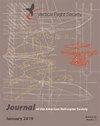旋翼悬停升沉面分析模型的建立
IF 1.4
4区 工程技术
Q2 ENGINEERING, AEROSPACE
引用次数: 0
摘要
采用与经典的、解析的、静态的地面效应模型相似的方法,建立了旋翼悬停在地面效应上的势流模型。利用旋翼在水面悬停进行单自由度升沉运动的实验性能测量对模型进行了验证,并对具有代表性的海军直升机产生了潜在的任务趋势。与以往的经验模型不同,目前的模型能够捕捉转子轮毂高度以及地面运动参数的影响。提出了一种新的推力比,将升沉表面上产生的地效推力与静态表面上产生的地效推力进行比较。在较高的集体螺距设置和轮毂高度下,模型预测的经典推力比在大约75%的测试点的测量值的5%以内。相对于静态表面的推力比被发现产生了更好的一致性,并且大约80%的实验测试点被预测在实测值的5%以内。本文章由计算机程序翻译,如有差异,请以英文原文为准。
Analytical Model Development for Rotors Hovering Above Heaving Surfaces
A potential flow model was developed for rotors hovering in-ground-effect above a heaving surface using a similar methodology to classical, analytical, static ground effect models. Experimental performance measurements for rotors hovering above a surface undergoing single degree-of-freedom heaving motion were used for model validation, and potential mission trends were generated for a representative naval helicopter. Unlike prior empirical models, the current model was able to capture the effect of rotor hub height as well as ground motion parameters. A new thrust ratio was proposed that compared the thrust produced in-ground-effect above a heaving surface to that produced above a static surface. Better agreement was found to occur at the higher collective pitch settings and hub heights, with the model predicting the classical thrust ratio within 5% of the measured value for approximately 75% of the test points. The thrust ratio relative to a static surface was found to produce better agreement, and approximately 80% of the experimental tests points were predicted within 5% of the measured value.
求助全文
通过发布文献求助,成功后即可免费获取论文全文。
去求助
来源期刊

Journal of the American Helicopter Society
工程技术-工程:宇航
CiteScore
4.10
自引率
33.30%
发文量
36
审稿时长
>12 weeks
期刊介绍:
The Journal of the American Helicopter Society is a peer-reviewed technical journal published quarterly (January, April, July and October) by AHS — The Vertical Flight Society. It is the world''s only scientific journal dedicated to vertical flight technology and is available in print and online.
The Journal publishes original technical papers dealing with theory and practice of vertical flight. The Journal seeks to foster the exchange of significant new ideas and information about helicopters and V/STOL aircraft. The scope of the Journal covers the full range of research, analysis, design, manufacturing, test, operations, and support. A constantly growing list of specialty areas is included within that scope. These range from the classical specialties like aerodynamic, dynamics and structures to more recent priorities such as acoustics, materials and signature reduction and to operational issues such as design criteria, safety and reliability. (Note: semi- and nontechnical articles of more general interest reporting current events or experiences should be sent to the VFS magazine
 求助内容:
求助内容: 应助结果提醒方式:
应助结果提醒方式:


